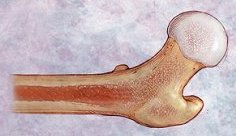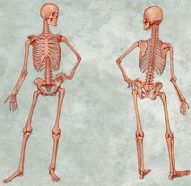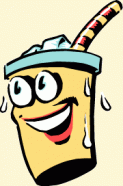Strong Bones for Life
Weak bones are an increasing problem for kids and teenagers.
By Emily Sohn
If you’re like most kids, you probably think you’ll never get old. Achy joints, failing eyesight, heart attacks: These are things you won’t have to deal with for a long time, right? So why worry now?
As it turns out, the choices you make now can make a big difference in how you feel later in life. I recently learned this lesson the hard way.
It started with an injury: a cracked shinbone caused by too much running on hard pavement. My doctor suggested a bone scan, which showed that my bones are weaker than average. I don’t have osteoporosis, a disease that causes older people to shrink in height and break bones easily. But I’m close.
 |
|
Example of a human bone. |
For me, the diagnosis was a scary wakeup call. I’m just 27 years old, but already I’m worried about things that normally happen only to women more than twice my age. Will I break my hip if I slip on a patch of ice? Is it safe for me to go skiing, lift heavy boxes, play Ultimate Frisbee?
Perhaps what upsets me most is the realization that I might have avoided all of this if only I had thought ahead earlier in life. Childhood and adolescence are the most important times to build strong bones. For you, there’s still time. Doctors suggest a variety of foods you can eat and exercises you can do as a teenager to build strong bones for life.
Living tissue
Bones are amazing. They’re hard but flexible, and they’re lightweight but tough. Without bones, we’d be just puddles of skin and guts.
An adult person has 206 bones in his or her body. The outer layer of a typical bone is made of a hard material honeycombed with tunnels. This web of hollow pipes allows a bone to be strong and light. It also allows the passage of nutrients and waste. A protein called collagen gives a bone its elasticity. Chemicals known as calcium salts make a bone hard.
But, even though our bones support us, they’re easy to ignore. Unlike a cut or bruise, a weak bone isn’t visible or painful.
Osteoporosis is sometimes called a silent disease. People often don’t realize they have it until it has progressed so far that they break bones while doing ordinary things, such as walking down stairs or lifting heavy objects.
Osteoporosis happens mostly to older people. But I’m not the only woman in her 20s with weak bones. Increasingly, scientists are finding that weak bones are a problem in teenagers and even younger kids. That’s especially troubling because youth is the critical time for bone growth.
If you’ve ever seen a skeleton in a museum, you might think that bones are dead. In fact, bones are living tissue. They reshape and rebuild themselves many times as you grow and age.
 |
|
Front and back views of a human skeleton. An adult has 206 bones in his or her body. |
The cycle of building and breaking down bone changes over a person’s lifetime. Bone-building is fastest during the first 3 years of life and again during adolescence. By the time you’re in your 20s, the tissue in your bones is about as tightly packed as it’s going to get.
Measuring something called bone density tells you how tightly packed the bone tissue is. A high bone density normally shows that you have strong bones.
Once you get to be about 35 years old, bone tissue gets broken down more quickly than it’s replaced. This means that bones tend to lose tissue, and the bone density goes down. That’s when osteoporosis usually becomes a concern. And it’s a bigger risk for women than for men.
Food concerns
Getting the right kind of bone-building nutrition and exercise as a teenager is like putting money in the bank. Your bones can stay strong as you get older.
Unfortunately, many teenagers don’t think about their bones when they order lunch or decide what to do with their free time. They’d rather snack on chips or slurp soda than think about vitamins.
And parents don’t always set the best example. “I was standing by the elevator at Children’s Hospital,” says Susan Coupey, an adolescent medical specialist at Children’s Hospital at Montefiore in Bronx, New York. “There was a 2-year-old child being fed soda by his parents.”
 |
|
Unlike milk or fortified juice, a soft drink doesn’t provide calcium for helping to build strong bones. |
Junk food has few nutrients. It also fills you up, so you don’t eat enough of the good stuff. That’s one reason why many adults want schools to get rid of soda machines.
Doctors urge kids to get plenty of calcium, the mineral that makes bones strong. Calcium is also essential for keeping nerves, blood, and muscles healthy. When you don’t take in enough calcium, your body takes calcium out of your bones, which weakens your bones even more.
Although calcium is abundant in milk, yogurt, cheese, fortified juices, soy milk, and some nuts and vegetables, few people get enough of it. The Institute of Medicine recommends that kids between the ages of 9 and 18 get 1,300 milligrams of calcium every day. That’s roughly the amount of calcium in a quart of milk.
Yet fewer than 10 percent of girls and 25 percent of boys get that much, according to the National Osteoporosis Foundation. “The average calcium intake of adolescent girls in the United States is somewhere around 900 milligrams,” Coupey says. “Many take in just 600 to 700 milligrams.”
Paying attention
Now that I’ve started paying attention, I realize that getting enough calcium takes some effort. Getting 1,300 milligrams of calcium is equivalent to drinking about four glasses of milk, eating 10 cups of cooked broccoli, or having two glasses of milk, a cup of yogurt, and a glass of orange juice—every day!
And that’s not all you need. To absorb the calcium you eat, you have to take in a variety of other vitamins and minerals, including lots of vitamin D.
In the summertime, you get vitamin D from sunlight on your skin. Where I live in Minnesota, though, it’s too dark and cold much of the year to spend a great deal of time outside. To get the recommended 400 to 800 international units of vitamin D recommended for people my age, I drink 2 cups of fortified milk every day, and I take a vitamin supplement. The American Academy of Pediatrics now recommends that teenagers take a daily multivitamin that has 200 international units of vitamin D.
Getting enough exercise is also crucial. “There have been some really excellent studies showing the effectiveness of weight-bearing exercise and strengthening exercises on bone density,” Coupey says.
Any exercise at all is better than sitting in front of the TV. Walking and lifting weights, in particular, are great for building muscles that support and strengthen bone. Playing soccer, tennis, or basketball are also good options.
A recent study found that elementary school girls who did jumping exercises for 10 to 12 minutes, three times a week, built 5 percent more bone mass than did girls who didn’t do the exercises. That’s enough bone mass to buy women some extra bone strength later in life, said the scientists from the University of British Columbia who did the study.
Even if you’re glued to the TV set, why not do some jumping jacks during the commercials? Have a glass of milk or fortified juice and some almonds instead of a can of soda and chips.
The changes are small, but the payoff could be big. You might even be amazed at how good it feels to take care of your bones. Support them, and they will support you for many years to come.
Going Deeper:







